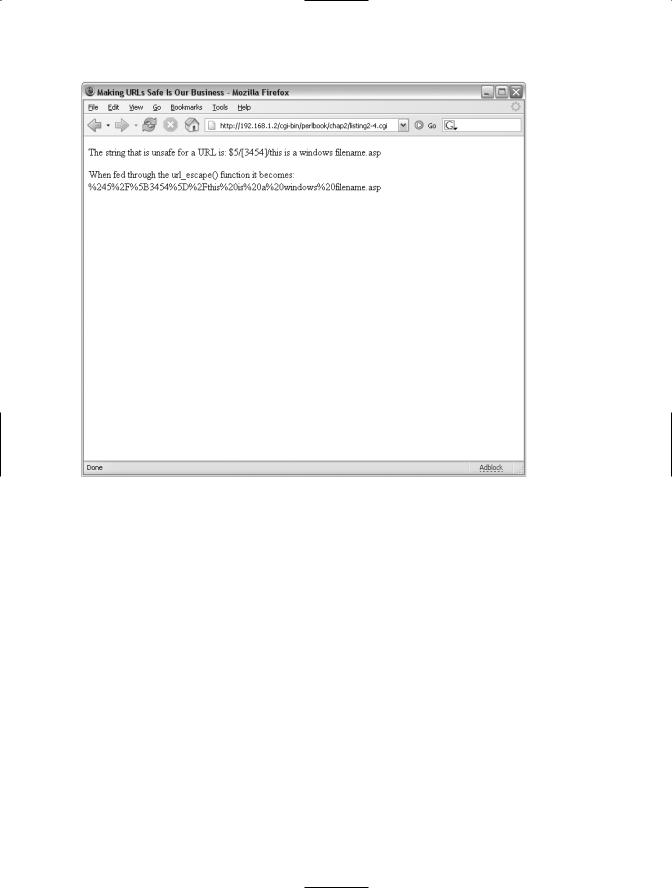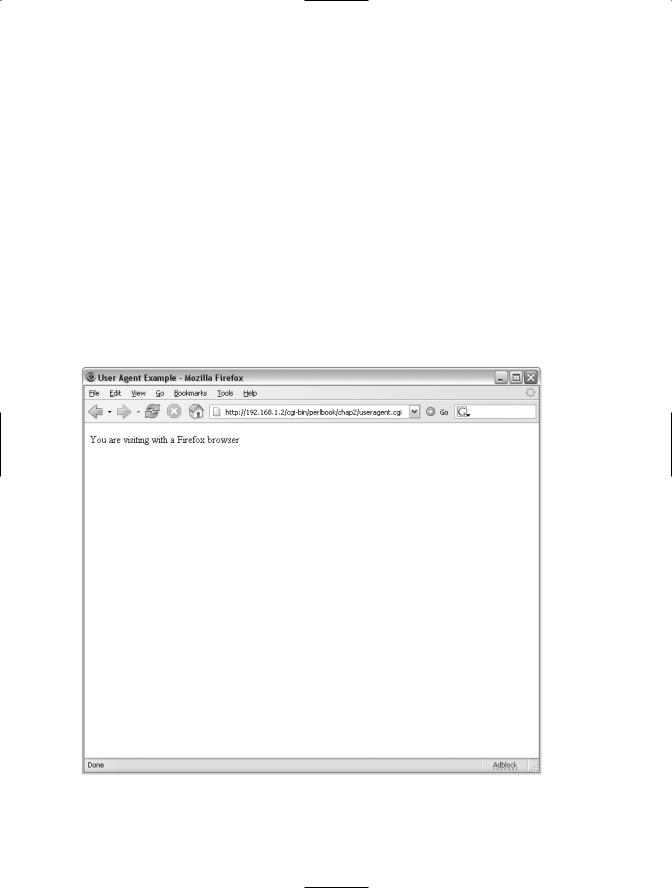
Beginning Perl Web Development - From Novice To Professional (2006)
.pdf
40C H A P T E R 2 ■ P O P U L A R C G I M O D U L E S
rules or standards for characters that are acceptable in a URI or URL.1 RFCs 2396 and 2732 define the characters that are restricted when they appear in a URL.
In essence, you must escape reserved and unsafe characters if they appear in the query string of the URI. Usually, you escape characters by changing the value for the reserved character to its hexadecimal (hex) equivalent preceded by a % instead of 0x. For example, the hex equivalent for a dollar sign ($) in a URL is %24; the URI hex for a space character is %20. Programmers familiar with Microsoft Windows web design might recognize the %20 as a space, since it’s more common to see spaces in filenames on Windows systems than on Unix and Unix-like systems.
In Perl, there’s more than one way to accomplish a given task, and escaping characters is no exception. There’s nothing preventing you from manually escaping each invalid character within a URI, and, in fact, a regular expression wizard could account for all instances of reserved and unsafe characters, and substitute them with their hex equivalents in one line of code. That’s an enjoyable exercise for learning regular expressions, but I’ve found that the URI::Escape module saves a lot of time in this area.
You can download the URI::Escape module from your favorite CPAN mirror (find mirrors at http://www.cpan.org/). This is probably one of the easiest Perl modules to use.
The URI::Escape module includes two primary functions: uri_escape($string) and uri_unescape($string). The uri_escape() function accepts an optional second argument containing a set of characters to be escaped, as opposed to the default set of restricted characters from RFC 2396. These characters include the following: ;, /, ?, :, @, &, =, +, $, ,,
[, ], -, _, ., !, ", *, ', (, and ).
When a string containing one of these characters is passed to the uri_escape() function, it will return a string with the restricted characters replaced with their safe counterparts. Conversely, when the uri_unescape() function receives a string with escaped characters, it will replace those escaped characters with their restricted, unsafe counterparts. Sometimes, the best way to explain things is with an example. Consider the code in Listing 2-4.
Listing 2-4. A Safe String Example with uri_escape
#!/usr/bin/perl -T
use strict;
use URI::Escape;
use CGI qw/:standard/;
my $unsafestring = "\$5/[3454]/this is a windows filename.asp"; my $safestring = uri_escape($unsafestring);
1.The difference between a URL and URI is subtle. A URL is a type of URI meant to show the location of the resource. The Internet Engineering Task Force (IETF) has published a number of Request For Comments (RFC) documents that define these and many other Internet standards. For more information, see
ditor’s web site (http://www.rfc-editor.org/).

C H A P T E R 2 ■ P O P U L A R C G I M O D U L E S |
41 |
print header,
start_html("Making URLs Safe Is Our Business"),
p("The string that is unsafe for a URL is: $unsafestring\n"), p("When fed through the url_escape() function it becomes: $safestring\n"),
end_html;
exit;
The code is pretty simple but illustrates the uri_escape() function very well. As usual, the URI::Escape functions are imported into the namespace with this code:
use URI::Escape;
From there, a string is created with all sorts of unsafe characters, including a $, brackets, and spaces. Notice the \ included in the string. The backslash doesn’t actually appear in the output, since it’s used to escape the $5, so that Perl doesn’t interpret the $5 as a variable!
my $unsafestring = "\$5/[3454]/this is a windows filename.asp";
The string is then run through the uri_escape() function, with the results placed into a variable called $safestring:
my $safestring = uri_escape($unsafestring);
The next lines of code in the example are ones that you’ve seen in earlier examples, beginning the web page output and so on. Two lines of output to the resulting web page are based on the output from the uri_escape() function:
p("The string that is unsafe for a URL is: $unsafestring\n"),
p("When fed through the url_escape() function it becomes: $safestring\n"),
First, you’re shown the string as it would appear before any escaping of unsafe characters (the variable $unsafestring). Next, the result of the uri_escape function is shown as the contents of the $safestring variable. Viewing the page through a browser, as shown in Figure 2-3, illustrates the results of the program.
Parsing an escaped URI string is a useful task, not only when programming for the Web, but also when performing forensics or monitoring security logs. Attackers and malicious code will frequently disguise their code by escaping it using the hex equivalent. Feeding that encoded string into the uri_unescape() function can help reveal the intent of such an attack. Listing 2-5 shows an example of using uri_escape().

42 C H A P T E R 2 ■ P O P U L A R C G I M O D U L E S
Figure 2-3. An escaped string viewed through a web browser
Listing 2-5. Using uri_unescape to Make a String Without Escape Characters
#!/usr/bin/perl -T
use strict;
use URI::Escape;
use CGI qw/:standard/;
my $unsafestring = "\$5/[3454]/this is a windows filename.asp"; my $safestring = uri_escape($unsafestring);
my $unescstring = uri_unescape($safestring);
print header,
start_html("Making URLs Safe Is Our Business"),
p("The string that is unsafe for a URL is: $unsafestring\n"),
p("When fed through the url_escape() function it becomes: $safestring\n"), p("When the escaped string is unescaped, it becomes: $unescstring\n"), end_html;

C H A P T E R 2 ■ P O P U L A R C G I M O D U L E S |
43 |
This code is similar to that shown in Listing 2-4. The additions to this code show the uri_unescape() function being run, as well as the results of that function call. As you can see in Figure 2-4, the string is indeed unescaped correctly.
Figure 2-4. An unescaped string viewed through a web browser
Two other functions within URI::Escape enable the developer to escape characters with a code above 255: uri_escape_utf8($string) and uri_unescape_utf8($string). These functions encode the characters as UTF-8 prior to escaping them. As with the normal uri_escape() function, the uri_escape_utf8() function also accepts an optional second argument containing a string of unsafe characters.
Net::SMTP
A somewhat common element in a web site is a contact form. These forms usually consist of a few form fields that enable the visitor to send a message to the business or web site operator. In the background, the contact form sends an e-mail message to the site operator or the intended recipient.

44 C H A P T E R 2 ■ P O P U L A R C G I M O D U L E S
Like so many other things in Perl, there are multiple way to accomplish the task of sending e-mail. One method is to use a mailto script such as FormMail.pl or another prebuilt mailer script. These scripts solve the problem, but many of them have historically had security holes or other issues that have allowed them to be abused. With that in mind, another solution is to use the Net::SMTP module to send the e-mail. Chapter 6 examines the use of Net::SMTP to send e-mail from a Perl script.
Mod_perl and HTML::Mason
Two essential characteristics of popular, high-traffic web sites are speed and frequent updates. Speed can be accomplished through many means, including the all-too-frequently used method of adding more and more servers to meet demand. While this is certainly necessary for the most popular sites and helps with redundancy, a better solution is to first look at ways to improve the performance of the server itself and the pages being served.
Updating a site frequently means that visitors will always have something new to view when they visit the site. Too often, companies put up a web presence and leave it as is, in
a static and unchanging mode forever. These same companies then wonder why no one visits their site. Updating a site is not a difficult task, but maintaining it over a long period of time can be a headache. Therefore, it’s important to make site maintenance as easy as possible.
To meet both the goals of adding speed through server optimization and making updates easy, many sites turn to an Apache module known as mod_perl for speed and the Perl module called HTML::Mason for easing the burden of frequent updates.
Mod_perl is an Apache module that greatly enhances the speed of CGI applications. Mod_perl embeds the Perl interpreter into the web server, thus making any CGI or Perl-based responses much faster.2 By preloading the CGI code, mod_perl maintains the application in a ready-to-run state, as opposed to needing to compile the CGI each time it’s run.
The drawback to mod_perl is that it is not recommended for use in a shared-hosting environment. In other words, if you use a web hosting provider and share the server with other users, the use of mod_perl makes it easier for malicious users to gain access to your application as it is running. Mod_perl will be discussed further in Chapters 10 and 11.
HTML::Mason (or just Mason) is a Perl module that enables execution of Perl code from within “Masonized” HTML files, and thus enables advanced templating. Such templating allows you to define a basic look and feel of a web site and plug text into the look and feel, thus easing ongoing maintenance of the site.
Designing an entire site from within a CGI application is cumbersome at best. Having to write each bit of HTML code as a line of Perl code is tedious and drives web developers positively mad. By using Mason, the HTML can be designed and then interspersed with Perl bits as appropriate. This frees the web developer to concentrate on the design of the web site. Mason requires mod_perl and is very powerful in its own right. Mason will be discussed in detail in Chapter 13.
2.Mod_perl does much more than merely enabling CGIs to be served faster. It also enables advanced usage of the Apache web server at a lower level than is possible through a normal CGI.

C H A P T E R 2 ■ P O P U L A R C G I M O D U L E S |
45 |
Interaction Based on Environment Variables
As noted in Chapter 1, environment variables, which are available to your programs from the server itself, can be useful for CGI programming. Using variables like the system time or the browser used by the client, you can change the behavior of your program. As an example of using environment variables, let’s look at displaying a page to the browser based on that browser and browser version.
Some sites misuse the HTTP_USER_AGENT and attempt to block visitors based on the value of this variable. Such sites frequently claim to work only in certain browsers. These sites are the result of poor design by someone who doesn’t understand the Internet. Since HTTP_USER_AGENT is based on a client-side setting, it can be forged or made to look like an acceptable browser. The user agent is covered in Chapter 5, where you’ll see how to change this value. You should not rely on any values coming from the client side when designing a web application, and you certainly don’t want to design a site that works with only certain browsers.
With that in mind, since different browsers and different versions of a browser render web pages differently, in some cases, it’s helpful to customize the page to suit the browser. But be aware that the customization may not work in all cases. In the end, it’s much better to design a site that adheres to well-defined and widely adopted standards, or at least default to these settings when the user agent cannot be determined.
Performing an action based on the HTTP_USER_AGENT variable is more of an exercise in Perl programming than an exercise in anything specific to CGI programming. Programming a set of conditional statements on the value of the variable is all that’s necessary, as shown in the example in Listing 2-6.
Listing 2-6. Determining the User Agent and Printing the Appropriate Result
#!/usr/bin/perl -T
use strict;
use CGI qw/:standard/;
my $useragent = $ENV{'HTTP_USER_AGENT'};
print header,
start_html('User Agent Example'); if ($useragent =~ /Firefox/) {
print p("You are visiting with a Firefox browser"); } elsif ($useragent =~ /MSIE/) {
print p("You are visiting with an Internet Explorer browser"); } else {
print p("Could not determine browser: $useragent");
}
print end_html;
exit;
The relevant bits of code within this program include the line to set the user agent into a local variable:

46 C H A P T E R 2 ■ P O P U L A R C G I M O D U L E S
my $useragent = $ENV{'HTTP_USER_AGENT'};
Next is the Perl conditional if-elsif-else to take an action based on a word found within the $useragent variable that is unique to the browser:
if ($useragent =~ /Firefox/) {
print p("You are visiting with a Firefox browser"); } elsif ($useragent =~ /MSIE/) {
print p("You are visiting with an Internet Explorer browser"); } else {
print p("Could not determine browser: $useragent");
}
Notice that if the browser cannot determine the browser, the default action is to do something sane to handle the problem—as opposed to producing an error or, worse yet, crashing, when this variable isn’t present or is something unexpected.
The result when viewing this program through a web browser is shown in Figure 2-5.
Figure 2-5. Using the user agent to determine the browser

C H A P T E R 2 ■ P O P U L A R C G I M O D U L E S |
47 |
Security Considerations with CGI Modules
Each module presents its own set of security issues. The CGI::Carp module, for example, can return too much information to the web browser with the fatalsToBrowser() method, which can result in information disclosure to potential attackers.
You should never trust input from any source, regardless of whether you’re using Perl or any other language. Any and all input should be sanitized and cleaned using things like uri_escape(), taint mode (discussed in Chapter 1), and other such modules and helpers.
Disallow all input by default, and then allow only the very smallest subset of valid input possible.
When you begin interacting with other systems and external clients such as web browsers, the potential for attack increases. I’ve seen countless web applications try to hide things from the client by disabling things like the View Source option in the web browser or by using other cute tricks that just don’t work. Some of the worst applications place database information directly within the code of the page and assume (or hope) that no one will bother to look at the source. Or the designers believe they can effectively hide those details from the client when they output them to the page.
In addition, these same designers employ only client-side validation using JavaScript and never bother to check the data on the backend. This leads directly to exploits against their database, such as SQL injection attacks and their related vulnerabilities. Always validate input from within your server-side program, regardless of what you do to validate that input from the client side. Never rely on anything that you get from the web browser, including things like the user agent.
Summary
This chapter examined some additional Perl modules used in web development. You saw the use of the CGI::Carp module to help debug programs. Then you looked at how to use the URI::Escape module to work with URLs and URIs in order to make them safe for use within your programs and for display. You were also introduced to some other modules that will be covered in greater detail later in the book, including Net::SMTP and HTML::Mason.
One item that was not covered in this chapter was interaction with databases, which is an important part of many CGI applications. The next chapter covers working with databases in your CGI applications.


C H A P T E R 3
■ ■ ■
Databases and Perl
Databases are vital to countless applications and play an important part in bringing applications to the Web. This chapter examines the elements involved in connecting to relational databases using Perl.
This chapter assumes that you are familiar with SQL. If SQL is just another acronym to you (it stands for Structured Query Language), I recommend that you refer to any number of excellent books on SQL or web sites that concentrate on SQL and the specific database server that you’ll be using for development.
LAMP is another acronym that you may have heard in the world of web development. LAMP is an abbreviation for Linux-Apache-MySQL-Perl/PHP/Python. The MySQL database portion of that acronym is of interest in this chapter. However, there’s nothing preventing you from using any other relational database with Perl, including Microsoft SQL Server. This chapter will look almost exclusively at MySQL, simply because it is so popular and well suited for web applications.
Interacting with a Database
Interacting with a database in Perl involves two pieces: the DBI and the database driver, or DBD. Each of these pieces is a Perl module. The DBI provides the software interface that is independent of the database, and the DBD provides the software that is database-dependent. This section discusses the DBI and the DBD for MySQL, and the role they play in connecting to a database through Perl.
The DBI
The DBI, an abbreviation for database independent or database interface (more commonly database independent), contains data-access libraries that are independent of the type of database. In other words, the DBI provides a generic interface on which you call a driver to access a database. This general interface allows you to use some common methods, regardless of the backend database.
The DBI is a module in itself, and thus is called into your program’s namespace with a use pragma:
use DBI;
49
